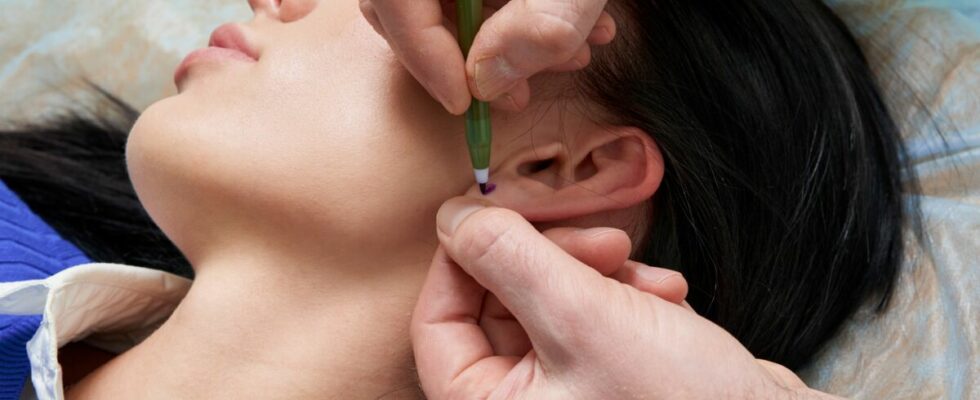According to Public Health Francenearly 6 out of 10 daily smokers wanted to quit smoking in 2021. To help them, there are methods recognized by health authorities, such as nicotine substitutes in particular, but also other methods such as anti-smoking lasers.
Anti-smoking laser: what is it?
The anti-smoking laser is a method based on ear acupuncture with the difference that the points treated at the pinna are not stimulated in the traditional way with a needle but using a gentle laser. “The significant advantage of treating specific nerve endings at the level of the ear with a gentle laser rather than with needles is to make this practice completely painless unlike the insertion of needles.“, specifies Christelle Lira, practitioner in ear reflexology and founder of the independent network of Stop Tabac laser centers. Stimulation of the points is done by frequency oscillation and the laser radiation comes in the form of short, high-power pulses. “Activating specific points on the pinna of the ear as well as the precise reflex zone of the nicotine addiction receptors makes it possible to deactivate these receptors and thus acts on the smoker’s dependence due to nicotine in a single session without nicotine substitutes. The method therefore acts on the need to smoke by accelerating and facilitating the process of smoking cessation. On the other hand, the method does not act on the desire to smoke because these are due to behavioral dependence and are therefore linked to the habits of each smoker.“, adds Christelle Lira.
Anti-smoking laser: the progress of a session
Even before the laser session, the practitioner takes the time to discuss with the person their smoking habits, their expectations and the hoped-for results. “The practitioner then determines the protocol most suited to the profile of the smoker, then moves on to the treatment which takes place in three stages: it begins with the precise screening of the points to be treated, continues with the laser treatment gentle on the points detected beforehand and ends with the placement of magrains (microbeads) or vaccaria seeds (from the vaccaria plant also called soapwort), on certain points in order to complete the treatment over a few days“, indicates Christelle Lira.
Anti-smoking laser: the results
According to its promoters, the anti-smoking laser has indisputable effects. “Our method has a success rate which varies between 75% and 85% over one year after treatment. However, it is important to note that some people may relapse during the year. In fact, 30% of people treated in one of our centers need a second session in the event of a relapse (we speak of a relapse from the moment when people have smoked even one cigarette again). 70% of people treated in one of our centers do not need a second session“, specifies Christelle Lira.
Anti-smoking laser: contraindications
Some people cannot be treated with the anti-smoking laser. This concerns first of all pregnant women because the treated areas are close to gynecological points which could cause contractions but also people with serious heart diseases or equipped with pacemakers. “This method is also not recommended for people taking major neuroleptics because these medications inhibit any nervous excitation, which makes detection of the points to be treated and therefore treatment difficult.“, underlines Christelle Lira.
Anti-tobacco laser: the opinion of the tobacco specialist
“At present, There is no evidence of the effectiveness of auriculotherapy and laser auriculotherapy on smoking cessation. However some studies show that theauriculotherapy and acupuncture may help reduce withdrawal symptoms when combined with psychotherapy, compulsive cravings and signs of anxiety. When patients ask me if they can use auriculotherapy, I tell them that they can do it in addition to the traditional validated methods of nicotine replacement and cognitive-behavioral therapy. Be careful, however, laser auriculotherapy is often very expensive, so it is better to go for acupuncture or traditional auriculotherapy. For my part, I particularly emphasize the importance of nicotine substitutes to overcome the physical dependence and cognitive-behavioral therapies to treat behavioral and psychological dependence, which is the only scientifically validated non-drug method“, explains Ketty Deléris, tobacco specialist specializing in addictions and author of the book I’m really stopping smoking (Ed. Marabout).
Read also:
⋙ What is auriculotherapy?
⋙ Stop smoking with acupuncture: is it effective?
⋙ How to stop smoking? The different methods that have proven themselves
